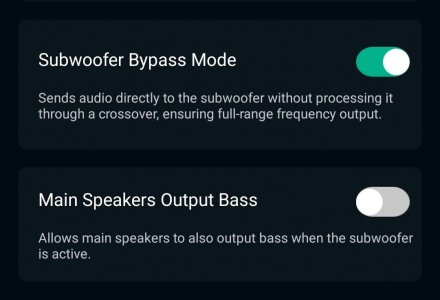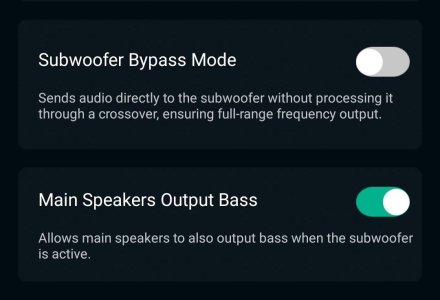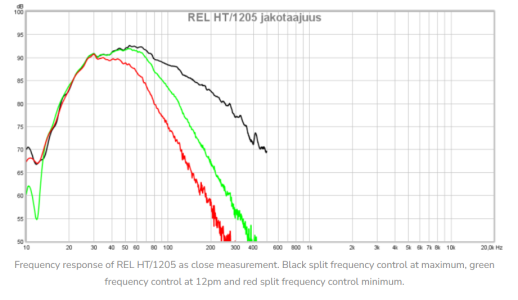You are using an out of date browser. It may not display this or other websites correctly.
You should upgrade or use an alternative browser.
You should upgrade or use an alternative browser.
The subwoofer crossover
- Thread starter TSHRED
- Start date
D
Deleted member 491
Guest
Both!Newbie question.
Is it considered a high pass filter or a low pass filter?
You can disable the low pass filter part by enabling Subwoofer Bypass Mode.

You can also disable the high pass filter by enabling Main Speakers Output Bass.

Before enabling either option you better know what you're doing and what the implications are. Even more so with both options enabled. In other words: Not touching both toggle switches is probably the best choice for 90% of all users. Leave the additional flexibility to those who have a specific reason.

You can also disable the high pass filter by enabling Main Speakers Output Bass.

Before enabling either option you better know what you're doing and what the implications are. Even more so with both options enabled. In other words: Not touching both toggle switches is probably the best choice for 90% of all users. Leave the additional flexibility to those who have a specific reason.
That single slider does both. 80hz default. Above 80 go to speaker below sub.Newbie question.
Is it considered a high pass filter or a low pass filter?
slartibartfast
Major Contributor
- Joined
- Apr 18, 2024
- Messages
- 5,239
Not really. Why would you do that? Let the sub handle below the crossover and the main speakers above the crossover.So it is recommended to put main speakers output bass set to enable?
slartibartfast
Major Contributor
- Joined
- Apr 18, 2024
- Messages
- 5,239
YesOké So I shut disable both sliders
It's not exactly ideal, at least in theory.Oké Thanks I ha e Now a crossover of 90hz because my dali fazon sat speaker lowest is 86hz and sub goes max 120hz is that correct
The Fazon Sat (being closed box speakers) have a natural roll-off of ~12 dB/octave below their resonant frequency. With the WiiM crossover set to 90 Hz (which is very close to 86 Hz) the effective combined filter slope of 36 dB/octave. The output of the sub (as filtered by the WiiM crossover) will have a filter slope of 24 dB/octave. For both outputs to sum up nicely the filter slopes should be symmetrical.
Unfortunately, things get even more complicated in real life. Dali don't provide any information how the f3 of 86 Hz was measured. In most cases this means the measurements was taken under unechoic conditions. The in-room response will probably be lower, depending on speaker placement. Also your sub might addsan additional filter with a crossover frequency of 120 Hz (the manual isn't that clear), so the effective acoustical filter slope will be somewhat higher than 24 dB/octave.
TL;DR:
Use the LFE input of your sub. This should disable the built-in crossover and the crossover knob should have no influence. Set the WiiM crossover to something between 90 Hz and 100 Hz by ear and proceeded as outlined in the other thread:
Sub settings?
Hi all, Fully aware that I’m going to have to tweak the settings but based on my below speakers https://www.sonusfaber.com/en/products/gravis-i/tech-specs https://www.sonusfaber.com/en/products/lumina-iii/tech-specs What Subwoofer settings should I start with? I’m using a NAD C268 power...
I actually found it very useful to cross my main speakers over @ 60hz in the wiim amp and then toggle the subwoofer bypass mode on and set my subwoofers LPF a little higher to 80hz. Reason being, I seemed to have a large dip between 50-70hz according to room correction and no matter where I set the crossover at in my amp, it would try to make huge corrections (like 8-10db boosts) in that region to smooth things out. Allowing the crossovers to overlap a little bit has significantly flattened everything out in my room from 50-80hz with only minor corrections (less than 3db corrections in that region and all the way up to 4k). Sounds quite nice too.
Yes, there are scenarios where this exact approach (overlapping sub and mains on purpose) can be helpful. As of now, using SBM and relying on the sub's crossover is currently the only way to obtain this flexibility. It's just not a general recommendation for everyone to try.I actually found it very useful to cross my main speakers over @ 60hz in the wiim amp and then toggle the subwoofer bypass mode on and set my subwoofers LPF a little higher to 80hz. Reason being, I seemed to have a large dip between 50-70hz according to room correction and no matter where I set the crossover at in my amp, it would try to make huge corrections (like 8-10db boosts) in that region to smooth things out. Allowing the crossovers to overlap a little bit has significantly flattened everything out in my room from 50-80hz with only minor corrections (less than 3db corrections in that region and all the way up to 4k). Sounds quite nice too.
I've posted this before, but one of the problems with many subs using analogue active filters is the broad variance in response caused by just changing the crossover frequency. This is one example for a REL subwoofer, but the behaviour is quite typical.

Just turning the "crossover frequency" knob actually changes the crossover frequency, the filter slope (depending on the actual value) and the frequency response within the pass band! RC can help mitigating the effects, but this makes adjustment a hit and miss game.
You surely wouldn't want to cross the tiny Fazon Sat speakers at 60 Hz, but I guess your posting was not targeted at that setup.
Yes, there are scenarios where this exact approach (overlapping sub and mains on purpose) can be helpful. As of now, using SBM and relying on the sub's crossover is currently the only way to obtain this flexibility. It's just not a general recommendation for everyone to try.
I've posted this before, but one of the problems with many subs using analogue active filters is the broad variance in response caused by just changing the crossover frequency. This is one example for a REL subwoofer, but the behaviour is quite typical.
View attachment 13367
Just turning the "crossover frequency" knob actually changes the crossover frequency, the filter slope (depending on the actual value) and the frequency response within the pass band! RC can help mitigating the effects, but this makes adjustment a hit and miss game.
You surely wouldn't want to cross the tiny Fazon Sat speakers at 60 Hz, but I guess your posting was not targeted at that setup.
No, not targeted specifically at his post since I don't know anything about his speakers. Just giving some insight that helped me. I have a pair of Elac DBR's so they play well enough down to 60hz.
There are many choice for you to pick and only you and ear can decide which one you pick. Choice one start with 80 and adjust the sub volume accordingly. Choice two you let the sub take over where the speaker show their -3db. Once everything set, run rc to fix peaks and dips.No, not targeted specifically at his post since I don't know anything about his speakers. Just giving some insight that helped me. I have a pair of Elac DBR's so they play well enough down to 60hz.
Thanks for your answer and timeIt's not exactly ideal, at least in theory.
The Fazon Sat (being closed box speakers) have a natural roll-off of ~12 dB/octave below their resonant frequency. With the WiiM crossover set to 90 Hz (which is very close to 86 Hz) the effective combined filter slope of 36 dB/octave. The output of the sub (as filtered by the WiiM crossover) will have a filter slope of 24 dB/octave. For both outputs to sum up nicely the filter slopes should be symmetrical.
Unfortunately, things get even more complicated in real life. Dali don't provide any information how the f3 of 86 Hz was measured. In most cases this means the measurements was taken under unechoic conditions. The in-room response will probably be lower, depending on speaker placement. Also your sub might addsan additional filter with a crossover frequency of 120 Hz (the manual isn't that clear), so the effective acoustical filter slope will be somewhat higher than 24 dB/octave.
TL;DR:
Use the LFE input of your sub. This should disable the built-in crossover and the crossover knob should have no influence. Set the WiiM crossover to something between 90 Hz and 100 Hz by ear and proceeded as outlined in the other thread:
Sub settings?
Hi all, Fully aware that I’m going to have to tweak the settings but based on my below speakers https://www.sonusfaber.com/en/products/gravis-i/tech-specs https://www.sonusfaber.com/en/products/lumina-iii/tech-specs What Subwoofer settings should I start with? I’m using a NAD C268 power...forum.wiimhome.com
So Now I have the crossover on the sub set to max 120hz and play with the crossover inthe WiiM ultra between 90hz and 100hz to my liking. That should be good?
MrA
Senior Member
- Joined
- Sep 16, 2024
- Messages
- 435
Yes, my DEQX digital preamp-processors allow four real-time presets (inc speaker configuration, crossover type, frequency & slope, time correction and PEQ settings). One controls three stereo channels for the main speakers and the other, two channels for a pair of subs.Yes, there are scenarios where this exact approach (overlapping sub and mains on purpose) can be helpful. As of now, using SBM and relying on the sub's crossover is currently the only way to obtain this flexibility. It's just not a general recommendation for everyone to try...
On three of these presets the main speakers and subs are crossed at 100hz 72dB with varying degrees of sub bass volume correction and on the fourth with the subs at 72dB and the main speakers with 48dB slopes and adjusted time correction plus a slightly lifted low bass response. My listening room has four solid walls and a solid floor so it tends toward 'cold' but using room correction, everything including bass is very tight and extremely dynamic, a feature of open baffle speakers which have been my preference for the past 14 years.
If I feel the need (rarely) to warm things up the fourth preset adds a degree more of that into the mix, akin to having a suspended floor. This setting is also perfect for certain 60s-70s LPs where for various reasons bass output was mixed low (Led Zeppelin 4 for instance).
My subs/speakers are crossed:
Subs 10-100hz ->72dB<- Speaker bass drivers 100hz-250hz ->168dB<- mid range drivers 250hz-2500hz ->48dB<- treble drivers 2500hz-22,000hz (ie crossovers at 100hz, 250hz, 2,500hz, all frequencies to 22kHz time aligned).
(many months of tweaking and fine tuning in 2016 to arrive at this combination of crossovers and slopes and I have not had any desire to change anything in the system since...apart from adding the WiiM Ultra!)
Last edited:
That's the kind of complex setup that has to be actively worked on for quite some time. No way doing it all by ear (nor all by measurement). Great, if you have the knowledge, the equipment and the time to do this.My subs/speakers are crossed:
Subs 10-100hz ->72dB<- Speaker bass drivers 100hz-250hz ->168dB<- mid range drivers 250hz-2500hz ->48dB<- treble drivers 2500hz-22,000hz (ie crossovers at 100hz, 250hz, 2,500hz, all frequencies to 2.5kHz time aligned).
(many months of tweaking and fine tuning in 2016 to arrive at this combination of crossovers and slopes and I have not had any desire to change anything in the system since...apart from adding the WiiM Ultra!)
I generally tend to recommend towards simple and conservative setups, something that's going to work well in most setups and configurations. Stuff like overlapping crossover frequcies or asymmetrical filters can provide better results in some situations and when applied by an expert user. I just ask to do it right the traditional way first. When looking for a better solution from there, you better know what you're doing and why and have the proper tools at hand.
As you said, room accoustics is a complex field and copying some very specific solution without proper knowledge of why this worked in a different setup doesn't do any good.
Last edited:
Similar threads
- Replies
- 27
- Views
- 808
- Replies
- 121
- Views
- 4K
- Replies
- 2
- Views
- 693
- Question
- Replies
- 7
- Views
- 681
- Replies
- 36
- Views
- 3K
